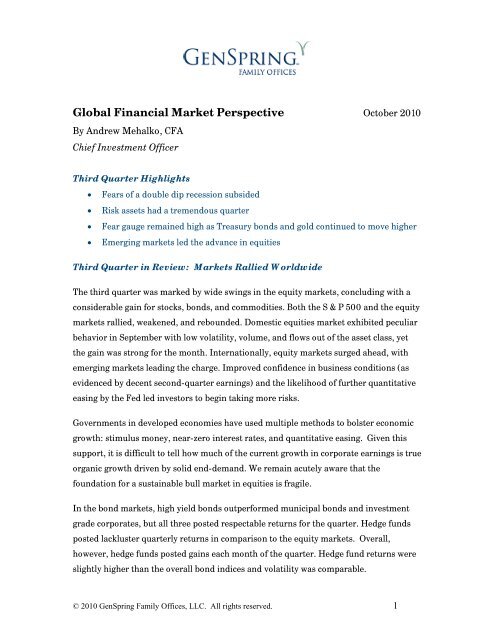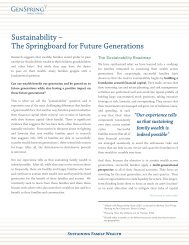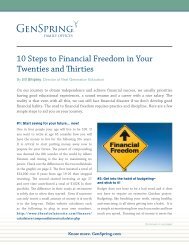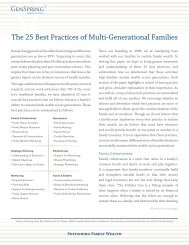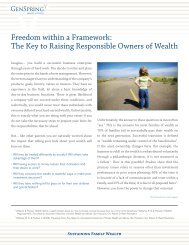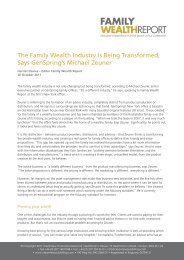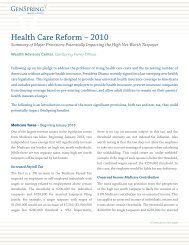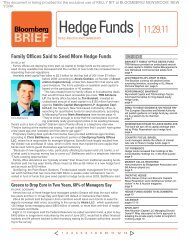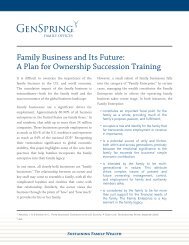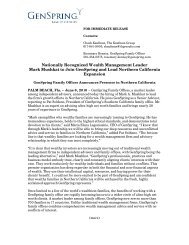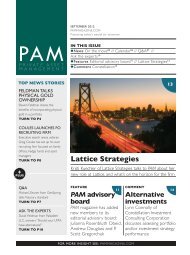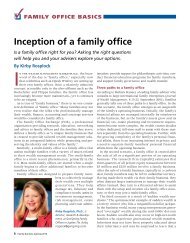View as a PDF file - GenSpring Family Offices
View as a PDF file - GenSpring Family Offices
View as a PDF file - GenSpring Family Offices
You also want an ePaper? Increase the reach of your titles
YUMPU automatically turns print PDFs into web optimized ePapers that Google loves.
Global Financial Market Perspective October 2010<br />
By Andrew Mehalko, CFA<br />
Chief Investment Officer<br />
Third Quarter Highlights<br />
Fears of a double dip recession subsided<br />
Risk <strong>as</strong>sets had a tremendous quarter<br />
Fear gauge remained high <strong>as</strong> Tre<strong>as</strong>ury bonds and gold continued to move higher<br />
Emerging markets led the advance in equities<br />
Third Quarter in Review: Markets Rallied Worldwide<br />
The third quarter w<strong>as</strong> marked by wide swings in the equity markets, concluding with a<br />
considerable gain for stocks, bonds, and commodities. Both the S & P 500 and the equity<br />
markets rallied, weakened, and rebounded. Domestic equities market exhibited peculiar<br />
behavior in September with low volatility, volume, and flows out of the <strong>as</strong>set cl<strong>as</strong>s, yet<br />
the gain w<strong>as</strong> strong for the month. Internationally, equity markets surged ahead, with<br />
emerging markets leading the charge. Improved confidence in business conditions (<strong>as</strong><br />
evidenced by decent second-quarter earnings) and the likelihood of further quantitative<br />
e<strong>as</strong>ing by the Fed led investors to begin taking more risks.<br />
Governments in developed economies have used multiple methods to bolster economic<br />
growth: stimulus money, near-zero interest rates, and quantitative e<strong>as</strong>ing. Given this<br />
support, it is difficult to tell how much of the current growth in corporate earnings is true<br />
organic growth driven by solid end-demand. We remain acutely aware that the<br />
foundation for a sustainable bull market in equities is fragile.<br />
In the bond markets, high yield bonds outperformed municipal bonds and investment<br />
grade corporates, but all three posted respectable returns for the quarter. Hedge funds<br />
posted lackluster quarterly returns in comparison to the equity markets. Overall,<br />
however, hedge funds posted gains each month of the quarter. Hedge fund returns were<br />
slightly higher than the overall bond indices and volatility w<strong>as</strong> comparable.<br />
© 2010 <strong>GenSpring</strong> <strong>Family</strong> <strong>Offices</strong>, LLC. All rights reserved. 1
Investment Return Expectations: What is Re<strong>as</strong>onable Going Forward?<br />
The amplified swings in the markets indicate that investors continue to be uncertain<br />
about the range of outcomes for the global economy. With equity markets advancing <strong>as</strong><br />
of late, investors seem to be gaining confidence in decent future growth prospects.<br />
However, the familiar concerns of high unemployment, weak housing markets, weak<br />
lending activity, and rising government debt and deficits linger, and rightfully so.<br />
Developed economies seem to be at an inflection point: are we stuck in a quagmire of<br />
sluggish growth, augmented by government intervention, or can we work through some<br />
of these structural problems and start to generate sustainable, real growth? If it is the<br />
latter, it will still take time to work through the problems; thus, for the foreseeable<br />
future, a low-growth, low-inflation, low-interest rate environment is the likely scenario.<br />
A future of constrained growth will likely lead to lower absolute returns for both stocks<br />
and bonds over the next three to five years.<br />
How Will Equity and Bond Markets Fare in a Low-Growth Environment?<br />
While we are seeing positive signs of economic growth in corporate America, the reality<br />
is that companies have had to cut many costs to weather the economic crisis and they are<br />
at a dead-end on further cost-cutting. There is concern about whether businesses will be<br />
able to organically maintain their upward revenue trends in a sluggish economic<br />
environment. Thus, <strong>as</strong> companies look to boost their growth, we expect to see continued<br />
acceleration in mergers and acquisitions. If they are unable to find good <strong>as</strong>sets to<br />
acquire, they will likely return c<strong>as</strong>h to shareholders in the form of dividends or share<br />
repurch<strong>as</strong>es. We expect dividends will be an important source of return for equity<br />
investors over the next few years.<br />
A very positive sign for economic growth will be a sustained upward trend in capital<br />
expenditures. At some point, companies will have to invest money in hiring, technology,<br />
and other overhead costs. Once this trend materializes, we should see some job creation<br />
so long <strong>as</strong> regulation and tax policy are not too uncertain or restrictive.<br />
Politics and Taxes Cloud the Picture<br />
The potential for a power shift in the November elections in the United States adds a<br />
layer of uncertainty in terms of how markets will perform. It is likely that the<br />
Republicans will take a majority control of the House of Representatives and the<br />
Democrats will maintain their hold in the Senate. While the net effect is greater balance,<br />
© 2010 <strong>GenSpring</strong> <strong>Family</strong> <strong>Offices</strong>, LLC. All rights reserved. 2
policy decisions will be harder to achieve, and true, positive change will become even<br />
more of a challenge.<br />
Tax changes scheduled to occur in 2011 may also alter the domestic picture. Tax cuts<br />
implemented in 2001 are scheduled to expire; income tax and dividend tax rates for high<br />
earners will climb; capital gains taxes will incre<strong>as</strong>e; and various income tax deductions<br />
will be reduced. In addition, the estate tax will return, and after 2012, a new Medicare<br />
contribution tax will be imposed on investment income <strong>as</strong> part of the health care reform<br />
bill.<br />
Portfolio Recommendations<br />
We encourage families to remain diversified <strong>as</strong> protection from a host of potential risks.<br />
Our preference is to always be patient and wait for opportunities that are attractively<br />
priced and fully reflect the range of future outcomes. After big upward swings in equity<br />
markets, investors tend to want to plow full-steam-ahead into stocks. We recommend<br />
equity exposure in the form of emerging markets, high quality large cap stocks, private<br />
equity, and long-short equity.<br />
We recommend the following exposures:<br />
<br />
<br />
<br />
High quality, dividend-paying stocks. At the right valuations, families should<br />
always have exposure to strong companies with clean balance sheets and good<br />
growth prospects. We favor businesses that employ low leverage, earn a portion of<br />
their revenue from international sources, and can weather through volatile<br />
environments. <strong>GenSpring</strong> h<strong>as</strong> recently added an investment manager who provides<br />
long-only exposure to these types of companies.<br />
Private equity. Periods following recessions have historically generated outsized<br />
returns in private equity. We believe this <strong>as</strong>set cl<strong>as</strong>s also allows families to own good<br />
businesses, and private equity better aligns ownership and management and shifts<br />
control to more focused owners and management teams.<br />
Emerging markets. Emerging market countries continue to incre<strong>as</strong>e their share<br />
of the global economy and strengthen their financial positions. Their fiscal balance<br />
sheets are healthier than those of developed nations with escalating debt from budget<br />
deficits.<br />
© 2010 <strong>GenSpring</strong> <strong>Family</strong> <strong>Offices</strong>, LLC. All rights reserved. 3
MLPs. Energy MLPs (M<strong>as</strong>ter Limited Partnerships) provide an attractive<br />
distributions yield, and are currently inexpensive relative to other yield-oriented<br />
equity cl<strong>as</strong>ses. These structures are tax-efficient and generally under-owned due to<br />
the fact that many institutional, tax-exempt entities are unable to invest in them.<br />
The overall demand for investment in new energy infr<strong>as</strong>tructure h<strong>as</strong> never been<br />
greater.<br />
Long/short equity managers are able to profit from a greater dispersion in<br />
corporate performance resulting from economic weakness. These managers identify,<br />
buy, and hold well-priced, stronger companies and sell short, over-priced, weaker<br />
companies.<br />
Multi-strategy managers are diversified and have the flexibility to find the most<br />
interesting trades across <strong>as</strong>set cl<strong>as</strong>ses. They participate in a wide range of<br />
opportunities and do not have to rely on good equity markets to deliver returns to<br />
investors.<br />
Credit alternatives. We recommend high yield-oriented credit alternative<br />
strategies that are more event-driven or favor dynamic exposure. These types of<br />
managers may participate if the rally continues, but are able to better preserve capital<br />
if the market declines.<br />
Global trading and CTA managers provide exposure to dynamic trading<br />
strategies. We favor a position in this <strong>as</strong>set cl<strong>as</strong>s <strong>as</strong> it exhibits a low correlation to<br />
equity markets, and managers are able to profit from a variety of macro themes.<br />
Gold h<strong>as</strong> significantly incre<strong>as</strong>ed in value and we are conscious that many investors<br />
are now directing capital into gold. We have recommended owning gold <strong>as</strong> a hedge<br />
against both currency devaluation and inflation. Gold h<strong>as</strong> historically held its value<br />
in inflationary scenarios, and it can also be used <strong>as</strong> an insurance policy against<br />
currency crises, war, and policy extremes. With respect to inflation, governments<br />
will choose inflation over deflation because it h<strong>as</strong> the effect of making debt<br />
obligations e<strong>as</strong>ier to pay back in the future. Also, despite lost purch<strong>as</strong>ing power,<br />
inflation generally feels better for the population <strong>as</strong> <strong>as</strong>set prices (housing, stocks) are<br />
rising. Given the now-elevated price of gold, we are looking for other methods for<br />
families to protect against these risks, though we continue to advise families to own<br />
gold.<br />
© 2010 <strong>GenSpring</strong> <strong>Family</strong> <strong>Offices</strong>, LLC. All rights reserved. 4
Keep in mind that investor constraints, preferences, and/or wealth planning objectives<br />
affect the application of these guidelines; thus, you should always discuss them with your<br />
<strong>GenSpring</strong> advisor. We encourage all of our families to work with their <strong>GenSpring</strong><br />
service team to make informed decisions about their portfolios and the guidance we<br />
offer.<br />
© 2010 <strong>GenSpring</strong> <strong>Family</strong> <strong>Offices</strong>, LLC. All rights reserved. 5
Disclosures and Definitions<br />
The information contained herein is neither an offer to sell nor a solicitation of an offer to<br />
purch<strong>as</strong>e any securities. Such an offer will only be made to qualified investors by means of a<br />
private placement memorandum and related subscription documents.<br />
P<strong>as</strong>t Performance is not necessarily indicative of future results.<br />
Benchmarks and indices: The valuation information presented for the various indices is available<br />
from public sources. <strong>GenSpring</strong> makes no representation <strong>as</strong> to its accuracy. Comparisons<br />
between a composite and an index are unreliable <strong>as</strong> performance indicators and should not be<br />
considered indicative of the actual performance to be achieved in a particular managed account.<br />
S&P 500 Index: The S&P 500 consists of 500 widely held common stocks, consisting of four<br />
broad sectors (industrials, utilities, financial and transportation). It is a market-value weighted<br />
index (stock price times shares outstanding), with each stock affecting the index in proportion to<br />
its market value. This index is a total return index with dividends reinvested.<br />
Barclays Aggregate Bond Index: Composed of U.S. investment grade fixed rate bond market,<br />
including government and credit securities, agency mortgage p<strong>as</strong>s through securities, <strong>as</strong>set<br />
backed securities, and commercial mortgage-b<strong>as</strong>ed securities.<br />
Barclays 5 Year Municipal Bond: Composed of state and local general obligation bonds, revenue<br />
bonds, insured bonds.<br />
Citigroup SB High Yield Index: covers much of the below investment grade U.S. corporate bond<br />
market. In it, previously published indices are combined to create a broad index for the highyield<br />
market. To enter the index, an issue must be rated speculative (BB+/Ba1) by S&P or<br />
Moody’s. An issue must miss a scheduled interest payment and allow the 30 day grace period to<br />
lapse before it is removed from the index.<br />
The HFRX Global Hedge Fund Index is designed to be representative of the overall composition<br />
of the hedge fund universe. It is comprised of all eligible hedge fund strategies; including but not<br />
limited to convertible arbitrage, distressed securities, equity hedge, equity market neutral, event<br />
driven, macro, merger arbitrage, and relative value arbitrage. The strategies are <strong>as</strong>set weighted<br />
b<strong>as</strong>ed on the distribution of <strong>as</strong>sets in the hedge fund industry<br />
Barclay BTOP50 Index: The BTOP50 Index seeks to replicate the overall composition of the<br />
managed futures industry with regard to trading style and overall market exposure. The BTOP50<br />
employs a top-down approach in selecting its constituents. The largest investable trading advisor<br />
programs, <strong>as</strong> me<strong>as</strong>ured by <strong>as</strong>sets under management, are selected for inclusion in the BTOP50. In<br />
© 2010 <strong>GenSpring</strong> <strong>Family</strong> <strong>Offices</strong>, LLC. All rights reserved. 6
each calendar year the selected trading advisors represent, in aggregate, no less than 50 percent<br />
of the investable <strong>as</strong>sets of the Barclay CTA Universe. To be included in the BTOP50, the following<br />
criteria must be met: Program must have at le<strong>as</strong>t two years of trading activity, Program's advisor<br />
must have at le<strong>as</strong>t three years of operating history, and the BTOP50's portfolio will be equally<br />
weighted among the selected programs at the beginning of each calendar year and will be<br />
rebalanced annually.<br />
The MSCI ACWI (All Country World Index) Index is a free float-adjusted market capitalization<br />
weighted index that is designed to me<strong>as</strong>ure the equity market performance of developed and<br />
emerging markets. As of June 2009 the MSCI ACWI consisted of 45 country indices comprising<br />
23 developed and 22 emerging market country indices. The developed market country indices<br />
included are: Australia, Austria, Belgium, Canada, Denmark, Finland, France, Germany, Greece,<br />
Hong Kong, Ireland, Italy, Japan, Netherlands, New Zealand, Norway, Portugal, Singapore,<br />
Spain, Sweden, Switzerland, the United Kingdom and the United States. The emerging market<br />
country indices included are: Brazil, Chile, China, Colombia, Czech Republic, Egypt, Hungary,<br />
India, Indonesia, Israel, Korea, Malaysia, Mexico, Morocco, Peru, Philippines, Poland, Russia,<br />
South Africa, Taiwan, Thailand, and Turkey.<br />
Morgan Stanley Capital International (MSCI) Europe, Australia, and the Far E<strong>as</strong>t (EAFE) Equity<br />
Index: MSCI EAFE acts <strong>as</strong> a benchmark for 23 “developed markets” stock portfolios,<br />
approximately 1000 companies. The average company h<strong>as</strong> a market capitalization of over $3<br />
billion. The index is presented with net dividends in US dollars.<br />
The MSCI Emerging Markets Index is an equity benchmark for emerging market stock<br />
performance. It is a capitalization-weighted index that aims to capture 85 percent of the total<br />
market capitalization and is rebalanced quarterly.<br />
The Dow Jones Industrial Average is a price-weighted average of 30 significant stocks traded on<br />
the New York Stock Exchange and the N<strong>as</strong>daq.<br />
The FTSE (London) index is the Financial Times Stock Exchange 100 stock index, a market cap<br />
weighted index of stocks traded on the London Stock Exchange.<br />
The Nikkei (Japan) is an index of 225 leading stocks traded on the Tokyo Stock Exchange.<br />
The Hang Seng (Hong Kong) index is a market-value weighted index of the stock prices of the 33<br />
largest companies on the Hong Kong market.<br />
© 2010 <strong>GenSpring</strong> <strong>Family</strong> <strong>Offices</strong>, LLC. All rights reserved. 7
Gold prices are sourced from Bloomberg and reflect the London Gold Market Fixing Ltd. PM Fix<br />
Price in U.S. dollars. Prices are quoted on a per ounce b<strong>as</strong>is.<br />
© 2010 <strong>GenSpring</strong> <strong>Family</strong> <strong>Offices</strong>, LLC. All rights reserved. 8


